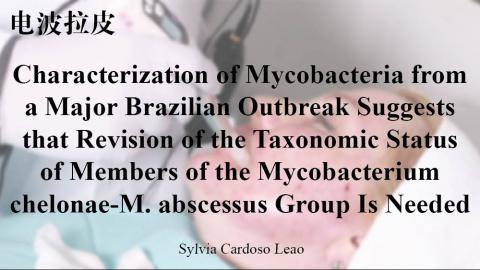
- 4463人
- 分享收藏
Characterization of Mycobacteria from a Major Brazilian Outbreak Suggests that Revision
简介
【 文献重点摘要 】
An outbreak of postsurgical infections caused by rapidly growing mycobacteria has been ongoing in Brazil since 2004. The degrees of similarity of the rpoB and hsp65 sequences from the clinical isolates and the corresponding sequences from both the Mycobacterium massiliense and the M. bolletii type strains were above the accepted limit for interspecies variability, leading to conflicting identification results. Therefore, an extensive characterization of members of the M. chelonae-M. abscessus group was carried out. The M. abscessus, M. chelonae, M. immunogenum, M. massiliense, and M. bolletii type strains and a subset of clinical isolates were analyzed by biochemical tests, high-performance liquid chromatography, drug susceptibility testing, PCR-restriction enzyme analysis of hsp65 (PRA-hsp65), rpoB, and hsp65 gene sequencing and analysis of phylogenetic trees, DNA-DNA hybridization (DDH), and restriction fragment length polymorphism (RFLP) analysis of the 16S rRNA gene (RFLP-16S rRNA). The clinical isolates and the M. abscessus, M. massiliense, and M. bolletii type strains could not be separated by phenotypic tests and were grouped in the phylogenetic trees obtained. The results of DDH also confirmed the >70% relatedness of the clinical isolates and the M. abscessus, M. massiliense, and M. bolletii type strains; and indistinguishable RFLP-16S rRNA patterns were obtained. On the contrary, the separation of clinical isolates and the M. abscessus, M. massiliense, and M. bolletii type strains from M. chelonae and M. immunogenum was supported by the results of PRA-hsp65, DDH, and RFLP-16S rRNA and by the rpoB and hsp65 phylogenetic trees. Taken together, these results led to the proposition that M. abscessus, M. massiliense, and M. bolletii represent a single species, that of M. abscessus. Two subspecies are also proposed, M. abscessus subsp. abscessus and M. abscessus subsp. massiliense, and these two subspecies can be distinguished by two different PRA-hsp65 patterns, which differ by a single HaeIII band, and by differences in their rpoB (3.4%) and hsp65 (1.3%) sequences.
自2004年以来,巴西一直在爆发由快速生长的分枝杆菌引起的术后感染。临床分离株的rpoB和hsp65序列与马氏分枝杆菌和波氏分枝杆菌类型菌株的相应序列的相似性程度都超过了可接受的种间变异极限,导致鉴定结果相互矛盾。因此,对龟分枝杆菌属(M.chelonae-M.)的成员进行了广泛的描述。实施脓肿组治疗。通过生化试验、高效液相色谱、药敏试验、hsp65、rpoB和hsp65的pcr限制性内切酶分析(pra-hsp65)、rpoB和hsp65基因序列分析、系统发育树分析、dna-dna杂交(Ddh)和16srrRNA基因的限制性片段长度多态性(Rflp)分析,对脓肿分枝杆菌、chelonae分枝杆菌、免疫原分枝杆菌、马氏分枝杆菌和波列蒂亚型分枝杆菌和部分临床分离株进行了分析。临床分离株和脓肿分枝杆菌、马氏分枝杆菌和博莱蒂亚型分枝杆菌不能通过表型试验分离,并归入系统发育树。DDH结果也证实了临床分离株与脓肿分枝杆菌、马氏分枝杆菌和博莱蒂亚型分枝杆菌的同源性>70%,并获得了难以区分的RFLP-16S rRNA图谱。相反,PRA-hsp65、DDH和RFLP-16S rRNA的结果以及rpoB和hsp65的系统发育树支持将临床分离株和脓肿分枝杆菌、马氏分枝杆菌和免疫分枝杆菌中的脓肿分枝杆菌、马氏分枝杆菌和博莱蒂分枝分枝杆菌的模式菌株分离出来,这一结果得到了PRA-hsp65、DDH和RFLP-16S rRNA以及rpoB和hsp65系统发育树的支持。综上所述,这些结果导致了脓肿分枝杆菌、马氏分枝杆菌和波勒提分枝杆菌代表单一种的命题,即脓肿分枝杆菌。文中还提出了两个亚种:脓肿支原体亚种(M.abscessus subsp.)。脓肿和脓肿分枝杆菌亚种。这两个亚种可以通过两种不同的PRA-hsp65图谱以及它们的rpoB(3.4%)和hsp65(1.3%)序列的差异来区分,这两种不同的PRA-hsp65图谱只有一条HaeIII条带。



